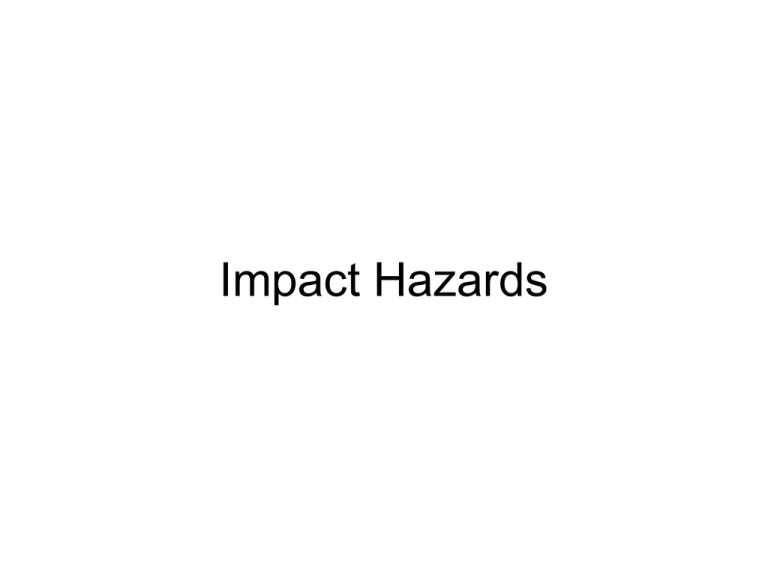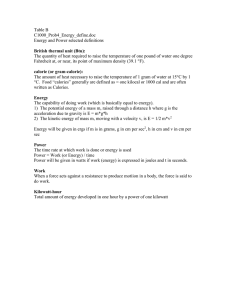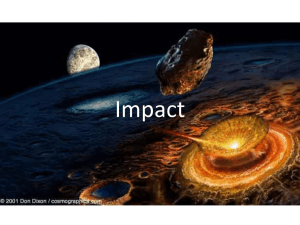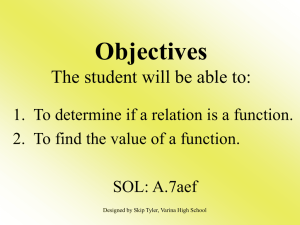Impact Hazards
advertisement

Impact Hazards Can we predict impacts? • Incomplete inventory of objects – May be a million km-sized objects • Initial observations don't permit completely accurate predictions • Comets vent gases and change orbits • The meaning of probability of impact – Planets don’t “wander” – Observational uncertainty Example, Measuring A Lot • You measure the lot 5 times, getting 99.7, 99.9, 100.1, 100.0 and 100.3 feet. • Average = 100 • Best estimate but might not be true value • Any random measurement has even odds of being too high or low • P All 5 too high or low = (1/2)5 = 1/32 • P 4 too high or low = 5/32 • P 3 too high or low = (5*4/2)/32 = 10/32 Impact Probability Impact Probability The Torino Scale of Impact Hazard • Named for the city in Italy, not a person • Assesses both probability of event and potential effects of impact, so measures two different things • Not completely consistent. The Torino Scale of Impact Hazard • Low or no hazard – 0 - No danger, or object too small to penetrate atmosphere – 1 - Normal. No likelihood of impact • Merits attention by astronomers – 2 - Close pass but no cause for concern – 3 - 1% chance of impact causing local damage – 4 - 1% chance of impact causing regional damage • Threatening – 5 - Close pass by object capable of causing regional damage – 6 - Close pass by object capable of causing global effects – 7 - Very close pass by object capable of causing global effects • Certain Impact – 8 - Impact capable of causing local damage or tsunami – 9 - Impact capable of causing regional damage or tsunami – 10 - Impact with global effects Torino Scale Meteorite Peekskill, NY 1992 Chondrite Stony-Iron Meteorite Iron Meteorite Meteo-Wrongs • Meteorites Never: – Have internal cavities – Have layers – Have veins – Flatten on impact – Mold around objects – Almost never light in color outside • If you “think” it’s magnetic, it’s not magnetic Nope Nope Uh-uh No Way Nope Nope Nope Tektites • • • • Very silica-rich, water poor glassy rocks Terrestrial vs. Extraterrestrial origin? Volcanic vs. Impact origin? Problems: – Odd chemistry – If terrestrial, why are they spread so widely? – If extraterrestrial, why are they so localized? • Now considered impact glass – Atmospheric shock wave evacuates atmosphere Tektites Spectrum of Impact Scenarios • Atmospheric impact and air burst (Tunguska, 1908) • Surface impact causing local damage • Surface impact with 100 km damage radius • Surface impact with 1000 km damage radius • Surface impact with global effects Tunguska, 1908 Tunguska, 1908 Sikhote-Alin Fall, February 12, 1947 Mass = 100,000 Kg Sikhote-Alin Crater Sikhote-Alin Crater Sikhote-Alin Crater Near Miss, August 10, 1972 1972 Near Miss • Object was about the size of a bus • Entered Atmosphere over Utah, travelling north, exited over Canada • Velocity 15 km/sec • Missed by 58 km Returning to Space Carangas, Peru, 2007 Carangas, Peru, 2007 What happens during impact • Atmospheric entry – Microscopic objects gradually decelerate – Millimeter-sized objects vaporize, seen as meteors – Meter-sized objects may fragment and survive passage – House-sized objects hit with force • Contact-compression phase • Transient crater phase • Rebound and collapse phase Impact Processes • Impact releases kinetic energy instantaneously – Explosion • Explosion scaling: Volume proportional to energy – Radius scales as cube root of energy • Energy Measures – Kiloton = 4.2 x 1012 Joules = 1012 calories – Megaton = 4.2 x 1015 Joules = 1015 calories – Note: Small “c” calories Kinetic Energy • • • • • • Assume 10 m rocky object Volume = 1000 m3, Density = 3000 kg/m3 Mass = 1000 m3 x 3000 kg/m3 = 3 x 106 kg Velocity = 30 km/sec = 30,000 m/sec K = ½ mv2 = ½(3 x 106 kg)(30,000)2 K = 13.5 x 1014 Joules = 270 Kt = 13 Hiroshima nuclear weapons What is an Explosion? • Instantaneous point release of energy • Can be mechanical, chemical or nuclear • Damage is caused by the surrounding material: air, water or solid • Explosions would cause little damage in space All Large Explosions Make Mushroom Clouds Environmental Effects of Impacts • • • • • • • Radiant heat and flash burns Blast wave Seismic waves Tsunami Ejecta Stratospheric dust Liberated volatiles (carbon dioxide, sulfur, methane) • Impact volcanism - a myth Averting Impact Hazards • Simplest Strategy: Detection + Diversion • Destruction too unpredictable – Can object be destroyed? – “Cookie crumbs have no calories” – In real life, the pieces matter • The longer the lead time, the easier diversion becomes • Only need a close miss • Detection is cheap and off-the shelf Diversion “The question is: how to do it? These things must be done … delicately.” • • • • • • Nukes? Thrusters? Space tug? Gravitational? Solar Sail Laser? Asteroid Itokawa




